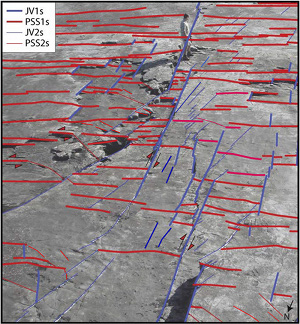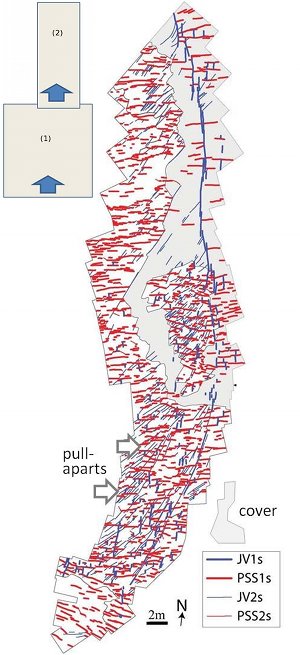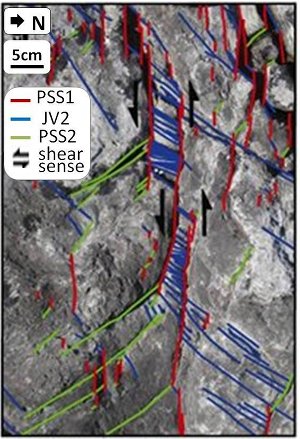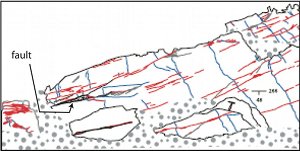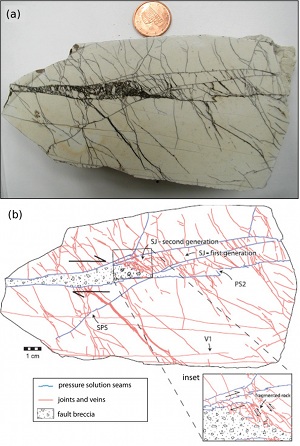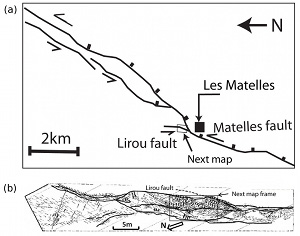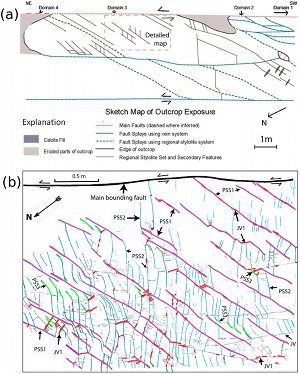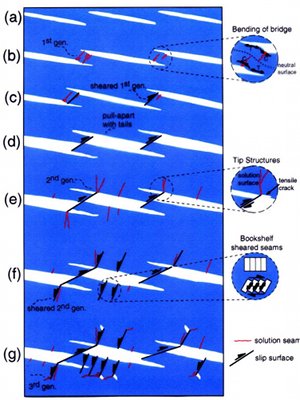| |||||||
|
|
|||||||
|
|
|||||||
| Faulting by Shearing of Vein and Pressure Solution Seam Assemblages | |||||||
|
There is a wide variety of configurations including pressure solution seams and veins, the shearing of which produces faults with a complex geometry. Perhaps one of the readily recognizable scenarios is that of shearing of orthogonal veins and pressure solution seams. Figure 1 shows such a case which was mapped on an oblique photograph of a sandstone platform taken from a higher mesa nearby. Thicker red lines are E-W trending pressure solution seams (PSS1) with splays (thin red lines-PSS2) when sheared in a left-lateral sense. Thicker blue lines are N-S trending quartz-filled veins (JV1) with splay veins (thin blue lines-JV2) when sheared in a right-lateral sense. Man for scale in the photo is Fil Nenna standing by the southernmost segment of the fault where the measured right-lateral slip is about 40 cm across the sheared vein. Further down south is the end of the southernmost large segment of the fault with numerous splay veins fanning out from the terminations of the sheared shorter echelon veins (Figure 2). Perhaps the most interesting deduction from the fans of splay veins (JV2) which are localized at the pull-aparts between the sheared pressure solution seams (PSS1) is that not only are they contemporaneous but also shearing of the PSS1 and propagation of JV2 and, consequently, shearing of JV1, were all harmonious (Figure 3). Figures 4 and 5 display a similar deformation style in limestone where a thin breccia zone filled by tar marks the fault zone. The inset in Figure 5b shows the details of the occurrence of a high density of splay veins between sub-parallel sheared seams thereby fragmenting the rock and initiating brecciation. Also common in nature is a process of shearing of either veins or pressure solution seams producing both veins and seams as splays. Perhaps one of the most impressive examples of this type of assemblages is that of a well-documented case from the Jurassic limestone cropping out in Lanquedoc, France (Rispoli, 1981; Petit and Mattahauer, 1995; Watkinson and Ward, 2006). Here, the largest structure is a series of left-lateral strike-slip faults, the southernmost strand of which is the Matelles fault (Figure 6a) attributed to the Upper Eocene Pyrenean shortening. There are also normal-slip faults in the area, for example, the Lirou fault (Figures 6a and b), and the normal slip is attributed to the Oligocene extension. A field sketch of an area identified in Figure 6b and a highly detailed map accomplished by 1:1 scale mapping are shown in Figures 7a and b, respectively. One of the left-lateral fault strands is marked as the main bounding fault in Figure 7b. According to Petit and Mattahauer (1995), this fault was formed by shearing of a pre-existing vein array. In fact, both Figures 6 and 7 have evidence of sheared veins sub-parallel to the bounding fault. The bounding fault is accompanied by a system of pressure solution seams (from oldest to youngest, PSS1 and PSS2, and PSS3) of which at least the two older generations were sheared. This deformation is also accompanied by a system of joints and veins JV1. The JV1 is actually more than one set of veins, some of which occur by opening of earlier pressure solution seams and veins and some others occur as short splays associated with the shearing of the pressure solution seam sets. Also marked as JV is a set of joints and veins, the age of which is ambiguous. Please note that PS3 becomes more-or-less parallel to PS1. A case somewhat similar to the one in the Lanquedoc area is fault development in the Jurassic limestone cropping out in the Bristol Channel (Peacock and Sanderson, 1995; Willemse et al., 1997). Figures 8a and b are detailed maps of two fault zones formed by initial opening across an echelon array of veins and formation of pressure solution seams at high-angle to the veins, which were subsequently sheared in a sense dictated by the opening across the veins. Figure 9 is a series of diagrams based on 1:1 scale mapping of the traces of assemblages to illustrate the formation of incrementally larger faults. Here the initial pressure solution seams were localized at the steps between echelon veins, the shape of which enhances the stress concentration leading to the initial pressure solution seams. Figure 9 (a) shows the initial stage of en echelon veins; (b) the development of two symmetrically arranged zones of solution seams in the contractional arches of the bending bridge; (c) the incipient pull-aparts form because of shear along the solution seams; (d) shows continued shear along first-generation solution seams leading to the development of pull-aparts; (e) second generation of solution seams, as well as tail cracks, form at the tips of sheared first-generation solution surfaces; (f) antithetic slip occurring along second-generation solution seams oriented at a high angle to the fault zone; (g) the third generation of solution seams, as well as tail cracks at the tips of the sheared second generation solution seams, forming a complex anastomosing network of discontinuities across the fault zone; (h) the solution seams and en echelon veins forming in a contractional relay ramp between two side-stepping fault segments; (i) synthetic and antithetic slip along the solution seams and en echelon veins causing the formation of opening-mode tail cracks and solution seams, progressively fragmenting the relay ramp. A through-going fault may eventually develop along the fourth generation of solution seams, linking both fault segments.
| |||||||
| Reference: |
|||||||
| Nenna, F., Aydin, A., 2011 Peacock, D.C.P., Sanderson, D.J., 1995 Petit, J.P., Mattauer, M., 1995 Watkinson, A.J., Ward, E.M.G., 2006 Willemse, E.J.M, Pollard, D.D., Aydin, A., 1996 Willemse, E.J.M, Peacock, D.C.P., Aydin, A., 1997 |
|||||||
|
Readme | About Us | Acknowledgement | How to Cite | Terms of Use | Ⓒ Rock Fracture Knowledgebase |
|||||||
